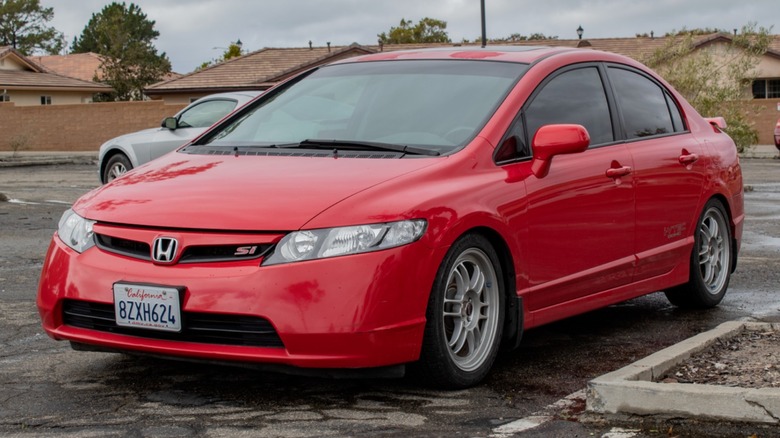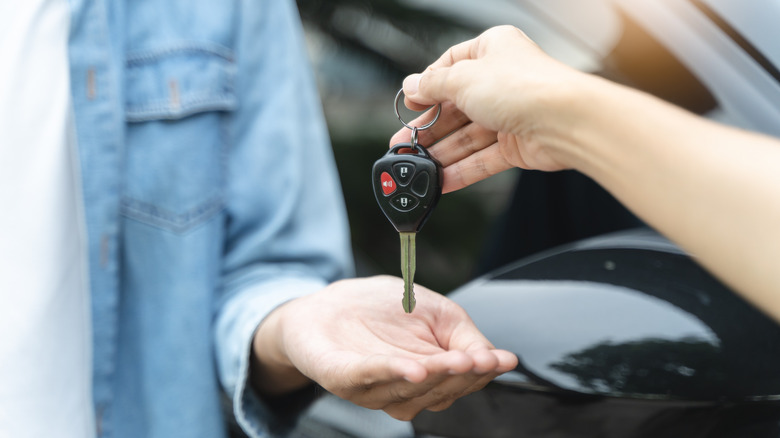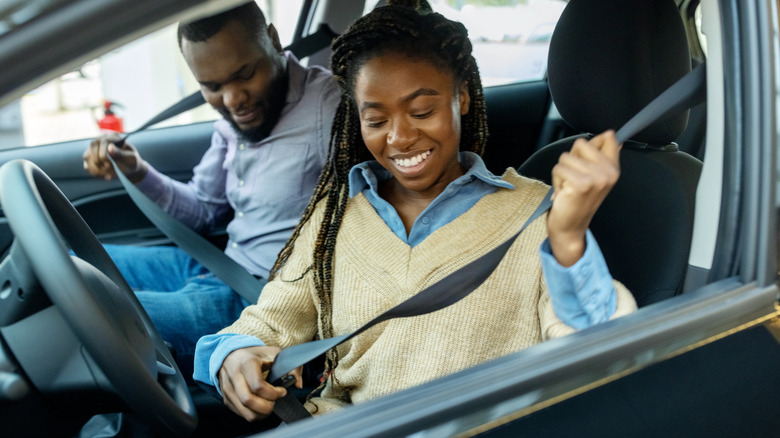Why First-Time Buyers Should Only Buy Cars From 2005 Or Newer, According To Jay Leno
For a newcomer to any activity, whether it's driving, investing, gardening, or anything else, there's one key way to learn: Extracting pearls of wisdom from veterans of that sphere. If you're lucky, they'll have a big platform from which they've frequently offered them. For new drivers, Jay Leno is just such a person, and potentially quite the resource.
On his popular Jay Leno's Garage series, he's showcased everything from a Doble E-20 from 1925 to the mighty McLaren W1, in all its 1,258 horsepower glory. He's not all about unique, extreme vehicles, though. If you're pondering your very first car purchase, which certainly isn't a decision to take lightly, he's got some advice for you on that score. Speaking to CNBC Make It in January 2018, Leno advised those buying a first car for eager young drivers, "don't get them an antique car. Get them something from 2005 forward, because at least they'll have airbags and seatbelts and all that kind of stuff."
As we age, we almost inevitably find ourselves reflecting that they don't make such-and-such like they used to, and in the world of car safety features, that's probably for the best. Leno advises that beginner drivers stick with models from – at the time of writing – the last twenty years, and it's plain to see why. Safety measures have become more stringent in the last two decades, and benefiting from this while also enjoying generally lower prices from an early 2000s or so model is certainly a boon too. There are some fantastic used cars that might be ideal choices for new drivers.
The advantages of a used 2005 and newer vehicle
Typically, a first car won't be a forever car. A new driver might choose a cheaper, more modest model in which to enjoy their newfound freedom, before upgrading to another when they feel confident enough to do so. Whatever the situation, many drivers would struggle to pay out for a brand-new car right off the bat, and so another practical concern of buying a car closer to the 2005 end of Leno's suggested timescale is a financial one. Auto Trader says that, after three years of ownership, a new car's value can fall by up to half. As such, a new car that you aren't intending to keep for the long term will tend to lose a lot of money when it's time to sell it on. There's less financial risk, then, in buying an older used model, both in terms of the initial outlay and, potentially, the amount you'll lose when selling it.
If you've ever seen a very special and rare old vehicle, lovingly maintained by its owner, or a one-of-a-kind auto museum exhibit, you'll know just how valuable such models can be in some instances. Classic cars can be very expensive to own and maintain as well. However, these are of course exceptional cases, and are far from the sorts of things that most of us will be driving as first cars. On top of which, of course, such models are often lacking the kind of safety features that drivers have come to expect and rely on today.
The crucial question of safety
Leno pinpointed safety basics such as airbags when recommending models from 2005 and later to new drivers, but the advancements in auto technology in this period encompass a lot of other technology beyond that. Additionally, a feature may not necessarily be designed for safety, but for quality of life and ease of use purposes. This can also be essential to help new drivers handle their vehicle, a concern even if that model isn't a particular powerhouse.
The unfortunate fact is that less confident, more inexperienced drivers are more likely to be involved in accidents on the road. According to the charity Brake, "Globally, road traffic crashes are ... the main cause of death among those aged 15–29 years." New drivers are advised to pick vehicles that pack the modern safety features that will support them. As Leno bluntly put it to CNBC Make It, "accidents you walk away from in a modern car would kill you in an antique car."
It's quite alarming to think that there was a time when cars, like school buses, didn't have safety basics like seat belts. Nonetheless, some safety features which were perhaps quite novel at first have become standard issue in all modern models. In September of 2011, for instance, electronic stability control became an essential feature for all new models, and seven years later, the same applied to camera systems that alerted the driver to approaching vehicles from different directions, crucial on busy roads. When modern technology — from crumple zones to proximity alerts and everything in between — can do, then, is both reduce the chance of a crash and dramatically increase survivability should the worst happen.


